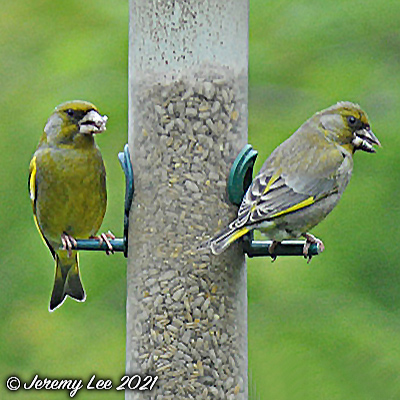
 |
|
Scientific Classifications explained » Amphibians » Ants » Aphids » Bees » Beetles » Birds » Bugs » Butterflies » Caterpillars » Damselflies » Dragonflies » Earwigs » Flies » Frog/Leafhoppers » Fungi » Galls » Grasshoppers » Harvestmen » Hoverflies » Lacewings » Ladybirds » Leaf Mines » Lichens » Mammals » Millipedes » Mosses » Moths » Sawflies » Slugs » Snails » Spiders » Trees & Shrubs » Wasps » Wild Flowers » Woodlice » Postboxes |
UK Nature > Birds > Carduelis chloris

Scientific Name: Carduelis chloris Common Name: Greenfinch With its twittering and wheezing song, and flash of yellow and green as it flies, Carduelis chloris, more commonly known as the Greenfinch, is a truly colourful character. Nesting in a garden conifer, or feasting on black sunflower seeds, it is a regular garden visitor, able to take advantage of food in rural and urban gardens. Although quite sociable, they may squabble among themselves or with other birds at the bird table. A recent decline in numbers has been linked to an outbreak of trichomonosis, a parasite-induced disease which prevents the birds from feeding properly. A common countryside bird found in woods and hedges, but mostly found close to man on farmland and in parks, town and village gardens and orchards. Only absent from upland areas without trees and bushes. Diet consists of seeds and insects and they can be seen all year round in the UK. |
|

https://www.uknature.co.uk is a website dedicated to showing the immense diversity of UK nature and wildlife. Our vast range of habitats, from lowland arable to snow covered mountains, from storm-ravaged coastlines to peaceful inland freshwater lakes and rivers, from dry, sandy heaths to deciduous and coniferous forests, all these habitats contribute to the abundance of UK nature. We have wild birds in huge numbers either residing or visiting our shores (597 recorded species as at July 2013) and we must also not forget the humble back garden with its grass lawns, flower beds filled with nectar rich flowers, shrubs and trees, all designed to attract huge numbers of insects such as bees, moths, butterflies and hoverflies; and finally the small ponds which provide safe havens for frogs, toads, newts and even slow worms and grass snakes. www.uknature.co.uk is the showcase for my personal passion, photographing uknature in all its glory. I sincerely hope you all enjoy the fruits of my labours. This site and all images contained therein is © Jeremy Lee 2004 - 2025. All Rights Reserved. Site design by Jeremy Lee. Site development & IT Support by Stuart Lee. |